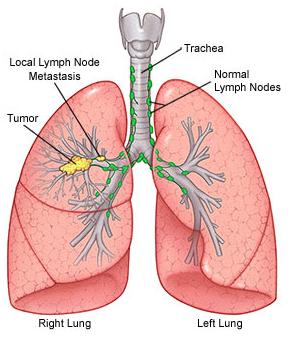| What is Lung Tumor? |
A lung tumor is the abnormal rates of cell division or cell death in lung tissue, or in the airways that lead to the lung. A tumor, or abnormal build up of tissue, may form when cells divide too quickly or do not die off as they normally should. Benign lung tumors are not cancerous so will not spread to other parts of the body, grow slowly, or might even stop growing or shrink. It is usually not life-threatening and can expand and push against nearby tissue but will not invade, destroy, or replace other tissue.

| What is lung tumor risk factor? |
There are many factors may increase risk of lung tumor. Some of risk factor can be controlled, for instance, by quitting smoking. Risk factor of lung tumor includes:
- Smoking
The risk of lung tumor is depending on the number of cigarettes smokes each day and number of years. Quitting at any age can significantly lower risk of developing lung tumor.
- Exposure to secondhand smoke
Even if don’t smoke the risk of lung tumor increase if exposed to secondhand smoke.
- Exposure to radon gas
Radon is produced by the natural breakdown of uranium in soil, rock and water that eventually becomes part of the air breathe. Unsafe levels of radon can accumulate in any building, including homes.
- Exposure to asbestos and other chemicals
The workplace exposure to asbestos and other substances known to cause tumor such as arsenic, chromium and nickel also can increase risk of developing lung tumor especially to those who smokes.
- Family history of lung tumor
People with a parent, sibling or child with lung tumor have an increased risk of the disease.
| How Lung Tumor Diagnosed? |
There are many tests to diagnosed cancer or tumor and find out if it has spread from the lung. Some test may also determine which treatment may be the most effective. There are several options to diagnosed lung tumor:
- Biopsy
Biopsy is the removal of a small amount of tissue for examination under a microscope. It is helpful to have a larger tumor sample in order to determine the subtype of NSCLC and to do additional molecular testing. If not enough of the tumor is removed to do these tests, another biopsy may be needed.
- Bronchoscopy
Bronchoscopy using a thin and flexible tube with a light on the end passes into the mouth or nose, down through the main windpipe and into the breathing passages of the lungs. The surgeon then specializes in the diagnosis and treatment of lung disease. The doctor can see inside the lung. Tiny tools inside the tube can take samples of fluid or tissue to examine. During this treatment, the patient are given mild anesthesia which medication to block the awareness of pain.
- Bone marrow biopsy and aspiration
This treatment occasionally used for small cell lung tumor. Bone marrow has both a solid and liquid part. A bone marrow biopsy is the removal of a small amount of solid tissue using a needle and aspiration removes a sample of fluid with a needle. A common site for a bone marrow biopsy and aspiration is the pelvic bone, which is located in the lower back by the hip.
- Ct scan
Ct scan is testing that produce images that allow doctor to see the size and location of a lung tumor. A CT scan creates a three-dimensional picture of the inside of the body with an x-ray machine. A computer then combines these images into details, cross-sectional view that shows any abnormalities of tumor.
- Bone Scan
A bone scan uses a radioactive tracer to look at the inside of the bones. Then, the tracer is injected into a patient’s vein. It collects in area of the bone and is detected by a special camera. Gray color will appear in the camera if it is healthy bone otherwise dark gray color will appear if it is area of injury or caused by tumor. PET scan has been replacing bone scans to detect lung tumor that has spread to the bones.
 |
Search for Best Treatment Lung Tumor in Google search here
|
